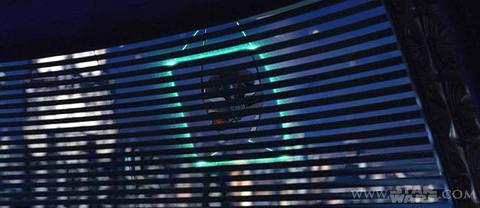
Warning: Massive Spoilers!
Written: 2002-05-28
Last Revised: 2002-06-15

Amidala's diplomatic quarters had a visible energy field outside the windows (perhaps a ray shield that blocks blaster bolts but not physical objects, since Obi-Wan wasn't fried when he jumped through). You could clearly see this field when the assassin droid used some kind of specialized beam in order to make a small square breach, in order to access the window and cut a hole so it could insert the kouhouns. The novelization describes it as follows:
"She didn't see the small round droid hovering behind the blinds outside her window. She didn't see the appendages come out of it, attaching to the window, or the sparks arcing about those arms as the droid shut down the security system."
The novelization's description is different from onscreen events; it describes electrical arcing from a set of appendages which shut down the security system, but we saw neither sparks or appendages. If this "security system" were an intrusion detection system as opposed to a ray shield, it seems rather useless if a droid can come along and mess around with it without setting it off! It seems more likely that this security system was actually a ray shield, designed to protect against sniper fire.
A ray shield is an obvious and sensible security measure in light of the sniper risk, but the existence of specialized tecnologies for breaching the system at close range calls Anakin's judgement into doubt. Was it Jedi foresight that led him to conclude that Amidala would be safe, alone in that room? Or was it Jedi arrogance? If that assassin droid had dropped a thermal detonator into that room instead of a pair of kouhouns, there wouldn't have been enough left of Senator Amidala for an identification from dental records.
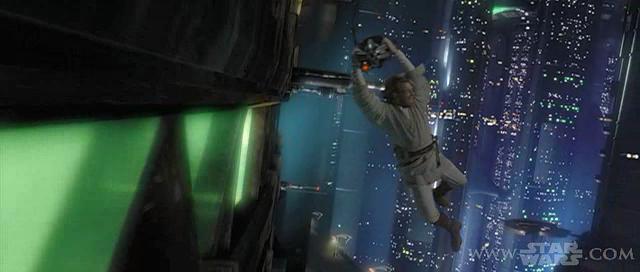
Not only do we learn that Zam Wessel's assassin droid has a specialized shield-breaching weapon, but its repulsorlift unit has such a large safety factor that it easily handles the added weight of an adult male human, leaping onto it and hitching a joyride! It also appears to have enough intelligence to try to shake him off, as it repeatedly juked around to loosen his grip, and even tried to slam him into obstacles on the way back to Zam Wessel's location.
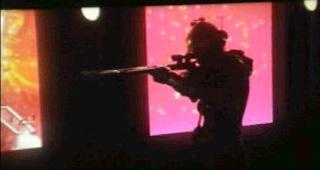
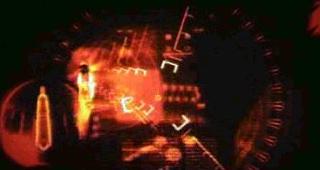
Zam Wessel's sniper rifle was the first canon example of the view through a rifle-scope in Star Wars. It was obviously not a simple optical scope, as the image was clearly computer-enhanced. Interestingly enough, the binoculars built into her helmet provided a similar view, albeit without the lock-on graphics (and with an obvious binocular cut-out shape). This may suggest that this appearance is fairly typical of such devices in the Republic, since a certain level of interface standardization is obviously beneficial.
She appeared to be quite a good shot, as she steadied her rifle solely with her arm strength and picked off the droid (a moving target!) at what appeared to be considerable range. In fact, she was almost too good. It seems highly unlikely that someone could steady a rifle solely with arm strength and pick off a small target at that range; could we chalk this up to the fact that she wasn't human, and perhaps had superhuman muscle control? Or does it mean that the gun fired some kind of homing projectile?
An alternate explanation is that the gun has an auto-fire capability, so that the sniper can move the gun around until it's lined up on the target and then it will shoot automatically. The lock-on graphics indicated that the scope had enough intelligence to differentiate the target from background objects, so it stands to reason that they gun may have this capability.
The real trick is to figure out exactly how long the range was. Obi-Wan didn't seem to be growing too quickly in the scope despite the great speed of the assassin droid as it sliced through the air, so I thought they must be quite far away. However, it might be easier to make this sort of determination once the DVD comes out.


We learned a few things about the Jedi archives in the course of AOTC. First, we discovered that according to the librarian Jocasta Nu, they've mapped every star in the entire galaxy, so that any galactic star system missing from the Jedi Archives must not exist. This is hardly a surprise, given the age of galactic civilization and the speed of hyperdrive. For those of you who watch too much Star Trek and don't understand why certain Trek paradigms do not always apply, this is also one of the reasons that Star Wars ships do not carry specialized sensors and equipment for mapping and cataloguing celestial phenomena; it's already been done, so why bother?
We also discover that the Star Wars galaxy has two satellite galaxies, that the Jedi Archives seem to be composed of huge numbers of luminescent cartridge-shaped storage devices, and that galactic maps can be displayed either on a two-dimensional terminal or in a three-dimensional holographic display, from data stored in a pinball-sized device.
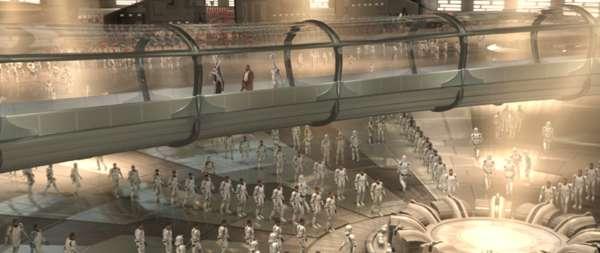
The Kaminoans do a fairly good job of describing their own activities, so they don't require much in the way of analysis. Nevertheless, there are a few items of note:
The Kaminoans say they have produced 200,000 "units", with another million "units" to be ready shortly. It is widely assumed that a "unit" is an individual trooper, however, it should be noted that it might also be a squad, a company, a batallion, or a division. 1.2 million soldiers is a rather small figure for a galactic army, particularly when its principal opposition (battle droids) can be manufactured in factories which pump out many tens of thousands of droids per day.
The cost of raising a clone from birth is prohibitive, and can be explained only through Palpatine's need for secrecy. A normal conscript costs the Republic nothing until he is recruited, whereupon he will undergo a few months of training and be ready for active service. A clone, on the other hand, must be bred, fed, raised, and trained from birth: a ten year long process. Each clone costs orders of magnitude more than a conscript. However, the clones can be purchased and trained in secrecy, so that they can be suddenly revealed with no warning. Without the clone army, Palpatine would have had to gain emergency powers and then start a public military recruiting program that would not bear fruit for months!
The Kaminoans say that the clones' genetic structure has been manipulated for "growth acceleration", and we see that their life cycle is largely natural, ie- they gestate in cloning chambers, are born as infants, and raised from infancy to adulthood. Growth acceleration cuts the maturation time down by a factor of two, so that clones reach physical maturity in 10 years. This is in direct contrast to the cloning method used in the Zahn trilogy, where clones are rapidly grown to adulthood in cloning chambers and then given a "flash" brain imprint. When comparing the two methods, the Kaminoan method is far more expensive and time-consuming, although it has the benefit of being more natural and producing clones who have been raised in squad units and who have literally spent a lifetime together and preparing for war, which should produce extremely strong "esprit de corps". There is some also question about the mental stability of clones who are raised too quickly (the ysalimiri supposedly compensated for this, although one of Thrawn's own clones seemed rather unstable in "Vision of the Future" despite their influence).
The Kaminoans say that the clones' genetic structure has been manipulated to be "more docile" and "less independent than the original host." This is rather interesting; it is assumed that reduced independence will make the clones ideal soldiers, but officers, NCOs, and even individual troopers (who can be differentiated by their colour-coding) need a certain amount of independent thinking capability in order to function effectively. It is conceivable that at the trooper and NCO level, this can be compensated for with sheer training (their entire lives are spent in military training, after all), but as one climbs the rank structure, a reduced capacity for independent thinking would become counterproductive. Perhaps the level of independence is genetically manipulated to be appropriate for different ranks. It may be that this aspect of their genetic design was intended to allow the Jedi to manipulate them directly. Some have also noted the possibility that Jango Fett had a remarkably strong tendency to defy authority, so the Kaminoans had to "dial down" this trait to normal levels just to make the clones controllable (thus implying that this characteristic was due to genetics rather than environment; see the endless "nature vs nurture" psychology debate).
One interesting aspect of their training relates to vehicles and heavy weapons. Kamino is completely covered in water (according to the books), and as such, there are no opportunities for realistic life-fire ground warfare exercises. Sterile simulations are of limited value because they cannot simulate the fear and adrenalin of combat, and there is always some question as to how realistic they really are. The heavy war machines and vehicles that they used were produced off-world, and all indications are that they never had a chance to use them (not counting simulators) before their baptism by fire on Geonosis. It is often said that you should never do something for the very first time while under fire, yet that is apparently what they did. Given those factors, they nevertheless performed quite admirably, showing no fear or hesitation under fire and demonstrating adequate skills at using the heavy equipment that had been provided for them. However, it should be noted that vehicle simulators generally work quite well, and it is only the ground troop action simulations that raise a question mark.
Some readers have noted that they might have performed live-fire training in large training domes, which are essentially hollow versions of the facilities visited by Obi-Wan. These chambers would have to be quite large in order to be an effective simulation, and very strongly built if they are to withstand water pressure and stray shots from live-fire exercises, although the latter problem could be mitigated by using lower-power shots. Another suggestion was that they performed combat training exercises on nearby moons or uninhabited planets so that their presence would not be known to the galaxy at large, but this raises the spectre of compromising security. Taking army groups on regular interplanetary or interstellar training missions would make it dramatically more difficult to maintain secrecy, particularly since habitable worlds suitable for realistic simulations might have uncharted settlements. The possibility of realistic and immersive holographic training environments was raised as well. Of the three suggestions, I find the first (training domes) most palatable from a realism standpoint, particularly if it is combined with holographic technology. However, the fact remains that not one soldier in the entire clone army had any real combat experience; they were all plucked out of their senior class with the same age (10 years) and experience (some simulated, none real).
Obi-Wan's Jedi Starfighter appears to have been built for minimum size, presumably to make the ship harder to hit. It is tiny, with less internal volume than some present-day automobiles. In fact, it is so small it requires the hyperdrive equivalent of a drop-tank in order to reach Kamino (or, as Obi-Wan once said, "a fighter that size can't get this deep into space on its own"). It is not immediately clear whether this is a hyperdrive range booster (literally analogous to a drop-tank), a hyperdrive speed booster, or an outboard hyperdrive unit, without which the ship cannot enter hyperspace at all. However, the novelization states that the fighter has no hyperdrive unit of its own, so that the ring is necessary in order to enter hyperspace at all. Supposedly, the Delta-7 is a brand-new design, and they just haven't had time to ramp up production of the hyperdrive yet, so they simply used an available commercial booster unit.
These units are interesting; are they normally used for temporarily converting inexpensive in-system craft to hyperdrive-capable craft for interstellar trips? Do people rent them so they can take the Space Winnebago to Coruscant for the weekend? They would be quite convenient from a consumer perspective (you don't have to build an expensive hyperdrive unit into every ship if you can just rent an add-on hyperdrive), but from a military tactical standpoint, they're a pretty bad idea. Someone using this fighter could conceivably be stranded if the ring is lost or destroyed, so it's not surprising that KDY would be in the process of designing and building a hyperdrive unit to fit into its small chassis.
The shape of the fighter is quite interesting in light of the fact that it is a KDY product (ref: SW2ICS). It would appear that at the time of the clone wars, the dagger-shape was very popular with KDY, as they used it for the Delta-7, the Acclamator, and eventually, most of the mighty Imperial warships of the classic trilogy. One interesting advantage of the dagger shape would be that the hyperdrive ring could theoretically accommodate several different sizes of fighter, by simply clamping on farther down the nose of the ship.
The fighter's battle damage was another point of interest; the hull was burned completely through in spots (from Slave-1 blasts which pulverized asteroids much larger than the entire Delta-7), but we could see exposed underlying cables which appeared to be completely undamaged. Could it be that the blasts had just enough power to burn through the hull but not enough to damage underlying cabling? Or does the ship have some kind of under-armour shield system which protected the cables?
AOTC appears to indicate the existence of direct long-range site-to-site hyperwave communications. This is in marked contrast to the situation in the so-called "extended universe", or EU, in which the so-called "Holo-Net" communications network is required for all but short-range transmissions.
These conclusions are based on the fact that the Delta-7's hyperwave transceiver could communicate with Coruscant from Kamino, but not from Geonosis. We saw Obi-Wan crawling over the ship and inspecting the damage, and he said that the transmitter was working, but Coruscant was "too far". He asked R4 to try Naboo, which was closer. He discovered that Anakin was on Tatooine from his "tracking signal", so he sent a message there.
The fact that range was an issue forces us to question whether the Delta-7's hyperwave transceiver uses the Holo-Net network described in the EU literature. If it is dependent upon Holo-Net nodes, why would it matter how far away Coruscant is? Were they outside the entire Holo-Net network? Even if they were, why would he express this by saying that Coruscant is "too far", instead of saying that they're out of the network coverage area? How would Obi-Wan even know if there's a Holo-Net relay within range without trying? Moreover, when Obi-Wan sent his message to Tatooine, he said that his long-range transmitter was down (he must have been talking about the short-range transmitter when he told R4 that the transmitter was OK), which further reinforces the speculation that the system relies upon a direct site-to-site connection.
The most straightforward explanation is that despite EU literature claims to the contrary, holographic communications do not necessarily employ the Holo-Net network, and that in this case, he was using a narrow-beam directed transmission instead, perhaps by using his hyperdrive ring in orbit as a booster relay. This would explain why he said the transmitter on his ship was working, but he told Anakin that his "long-range transmitter" was out; if the Geonosians destroyed the booster or he couldn't get a clear transmission to it through the dense orbital asteroid rings, he would be limited to short-range communications.
The existence of direct site-to-site hyperwave communications would make a lot of sense from a security perspective. Networked communications in a society of millions of star systems and countless trillions of sentient beings would be very difficult to secure, without wholly separate civilian and military networks. By establishing a direct end-to-end connection (possibly with encryption), he could cut down the number of potential eavesdroppers to those who happen to be situated along a straight line between Geonosis and Tatooine. Another advantage is the robustness of the system; there are obvious reasons why a navy would want to retain its communications if the network is damaged, and long-range hyperwave transceivers would allow them to do that. It may be that military communications tend to rely on straight-line transmissions while civilians, who cannot afford the expensive and power-draining hyperwave transcievers, must make do with the network (think of the difference between a cellular phone and a satellite phone in real life).
However, the existence of site-to-site long-range hyperwave communications is but one of two communications-related revelations in AOTC. The other comes from the fact that Obi-Wan was able to swiftly track down Anakin on Tatooine from his "tracking signal." But what generates this signal? It must not be too large, since Anakin and Amidala had only a few suitcases with them. Was it similar to the hand-held device that Obi-Wan used to track Slave-1? Is it something that Anakin had to consciously carry with him for this mission, or is it something that all Jedi carry with them on all missions? How could such a small device transmit over interstellar distances? If all Jedi carry a location beacon or transponder some sort, how secure are the codes for these transponders? Is it possible that Darth Maul had access to the codes required to trigger a response from the location transponders of Qui-Gon Jinn and/or Obi-Wan Kenobi on Tatooine, hence the ease with which he was able to locate them in TPM? Or was the tracking signal associated with R2D2, who was supposed to be in close contact with Anakin and Amidala throughout the trip?
One possible explanation is that the tracking signal was actually associated with Amidala's yacht, and not Anakin himself. Obi-Wan might have pre-arranged communications through Amidala's personal yacht for security reasons, knowing that Anakin would be able to use it as soon as they arrived on Naboo. This fits certain onscreen visuals: Obi-Wan's cockpit display showed a picture of Amidala's yacht even before he managed to locate him on Tatooine, which strongly suggests that he was looking for the yacht all along. On the other hand, if the yacht was expected to stay on Naboo and function as a mere "hotline" telephone number, why would he have pre-arranged a tracking signal, and why would he describe it as Anakin's tracking signal rather than asking R4 to look for the yacht? A tracking signal presumes that you need to determine its location, and as far as the original plan was concerned, this yacht wasn't supposed to go anywhere. The best explanation may be a hybrid of this one and the previous one: Obi-Wan and Anakin pre-arranged communications through Amidala's yacht, so Obi-Wan tried to contact it (hence the onscreen display). When he couldn't find it, he looked for Anakin's personal tracking signal instead. When he located Anakin on Tatooine, his communications system was finally able to make a connection to Amidala's yacht.
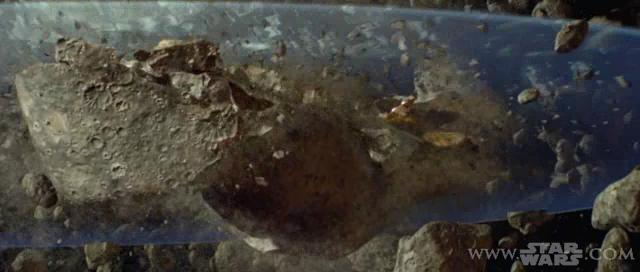
When you want to send a strongly worded message to an unwanted pursuer, just lob a seismic charge his way. The seismic charge is interesting not so much for its sheer power as for its unusual mechanism. Obi-Wan's starfighter could barely escape the blast, which spread outwards from each detonation and effortlessly shredded everything in its path. The limits of this blast were difficult to determine without being able to carefully inspect the entire scene in slow motion, but it appeared to spread out for at least 2 kilometres in all directions (limited to its plane, of course), if not much more.
If we use the 2 km figure (although it seems small in light of the duration of the blast and its expansion rate), its ability to pulverize everything within its range suggests energy yield of at least 60 to 200 megatons, based on empirical data derived from rock blasting. For those of you who are B5 fans, I am aware that some of you believe that the disintegration of a 500 metre wide asteroid (in "Call to Arms") was a gigaton-level event. However, I am not interested in debating that erroneous (and, I suspect, entirely arbitrary) figure; my source is "Deflection and Fragmentation of Near-Earth Asteroids", by T.J. Ahrens and A.W. Harris, which indicates that a 1 megaton bomb should disintegrate an asteroid between 0.7km and 1km width. In any case, the SW2ICS quantifies the mines to have roughly 12 gigaton yield, which suggests that the radius of destruction can be as much as 10-30 kilometres at maximum power (although it should be noted that conventional modelling is suspect because of the unusual mechanism of the weapon, and it is difficult to determine the true radius of destruction in the film because of the camera angles used).
This weapon is obviously not a conventional or nuclear explosive. It does not have a normal explosive effect, and it does not need to be buried inside an asteroid in order to fragment it. Its shockwave is planar, and the expanding planar disc appears to slice asteroids cleanly at the point of contact, while simultaneously imparting significant velocity to the resulting fragments in a direction perpendicular to the plane. It cannot be a conventional explosive device, but it may be an unusual application of forcefield technology. Note that rock fragments thrown away by the interaction are not heated to luminescence, nor do they show any other signs of heating. In fact, the rock appears to fracture in a brittle fashion.
The motivation for such a specialized device is not initially obvious. It can create impressive destruction in a dense matter field but it is of questionable value as a space weapon, since a starfighter need only avoid the planar disc in order to escape destruction (although flying debris created a secondary hazard in this case, and it would be interesting to see its effects on a large vessel which cannot avoid the disc). However, the name "seismic charge" strongly suggests that it is actually meant to produce seismic shockwaves on a planetary surface: an application for which its planar disc would be perfectly suited, provided it can orient its expansion plane to the ground. Jango Fett was improvising when he used this device against Obi-Wan's starfighter in the Geonosis rings, but when you look at its characteristics, it is obviously designed for use as a ground attack weapon.
With a sub-surface detonation, these seismic charges would create a devastating localized ground-quake which can destroy man-made structures within a radius of several kilometres by literally tearing up the ground beneath them. With surface detonations, these weapons would become the ultimate "daisy-cutter", able to catastrophically disrupt ground installations, vehicles, and of course, personnel. Best of all, this large zone of destruction woud be caused without any of the toxicity or radioactive fallout that normally accompanies the use of weapons powerful enough to devastate such a large area, thus allowing troops to rapidly seize control. Not coincidentally, it would also make it easy for a bounty hunter to quickly enter and retrieve bodies (or at least, parts of bodies) which are still readily identifiable for the purposes of bounty collection, since the weapon would not obliterate flesh with the searing heat and radiation that accompanies nuclear explosives.
Note the placement of the minelayer: on the bottom of the ship. The design intention was apparently for clearing out a landing area. If Slave-1 dropped to low altitude and needed to quickly clear out hostiles from the landing zone, it could drop a seismic charge to do the job, even from low altitude. Alternatively, if Jango Fett is fleeing pursuers, he need only get into the ship, take off, and drop a seismic charge as soon as his ship gets more than a few dozen metres off the ground. The blast would neutralize all but the most large-scale pursuit.
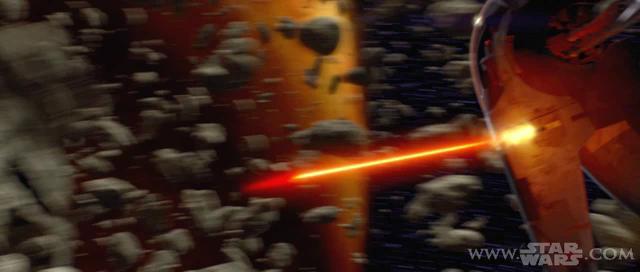
Unlike its seismic charges, Slave-1's midship guns were clearly designed for ship to ship combat. Their rate of fire was quite high (I estimate one shot every 3 frames at 24 fps, which averages out to roughly 480 shots per minute), which is appropriate for that task. It is unknown whether the firing rate of these guns is linked to their yield (ie- if the high refire rate comes at a cost in per-shot yield). However, at the yield setting used in this incident, each shot was capable of pulverizing asteroids larger than Obi-Wan's starfighter.
According to the SW2ICS, the midship guns have a per-shot yield of 2 kilotons, which would be enough to pulverize a well-consolidated 100-150 metre wide asteroid, assuming that the force-coupling efficiency of an energy bolt is equal to the force-coupling efficiency of a centrally buried chemical explosive. Of course, this is not the case, nor is it even close, so the 100-150 metre figure should be treated as an extremely generous estimate. An energy beam primarily heats the target, and the only form of force coupling is secondary, through gas expansion caused by rapid vapourization. Realistically, a 2 kiloton energy beam of perhaps 0.01 second duration would probably be limited to fragmenting an asteroid of only a few dozen metres in size rather than 100-150 (with a lot of heating, melting, and vapourization), which is closer to what we see in the film.
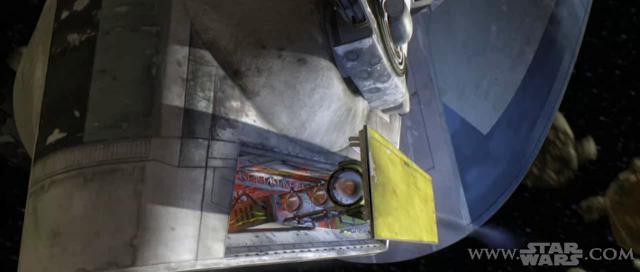
Slave-1's missiles are fairly conventional weapons, with a spectacularly effective guidance system. After firing, the missile tracked Obi-Wan's starfighter through a dense obstacle course, during which Obi-Wan deliberately flew through and around various asteroids without shaking its pursuer. Some of its maneuvers were very sharp, almost startling in their rapidity.
The intelligence and maneuverability of the missile was quite impressive; it performed very rapid course corrections with aplomb, flew through a hole in an asteroid to continue tracking its target, and at one point, it successfully reacquired the target after taking a different path around an obstacle than Obi-Wan did. However, its detonator was set off by the spare parts canisters dumped by Obi-Wan's fighter (perhaps it was a metal-proximity detonator), and it exploded prematurely.
It is extremely difficult to gauge the destructive effect of this explosion since it did not detonate on or inside an asteroid, and scaling is made more difficult by the camera angles and unknown distances (we only see the whole explosion from Jango's perspective, and we don't know how far back he is). Moreover, given the relatively short range at which Jango fired the missile, it would have been foolish to set it for maximum yield, so there's no real way to determine its yield from this incident. However, the SW2ICS quantifies their maximum yield at roughly 190 megatons: enough to pulverize an asteroid several kilometres in diameter (assuming it penetrates before detonating).
![]()
Jedi Knights obviously require extraordinary confinement procedures, as demonstrated by the use of both shackles and a confinement forcefield in order to hold Obi-Wan in a locked Geonosian prison cell. Obi-Wan and Anakin were subsequently brought out to the arena wearing only their shackles, and one might ask why they were unable to remove their shackles using the Force, since Emperor Palpatine could do it easily. There are two possible explanations:
Emperor Palpatine is much more powerful than Obi-Wan or Anakin, and this level of power is necessary to pick locks.
The Geonosians took special precautions with them, and welded their shackles shut (unlike Amidala's shackles).
The second explanation seems more plausible. It doesn't seem likely that the difference in power between Obi-Wan and Emperor Palpatine is necessary in order to pick locks. In fact, for all we know, Luke could have removed his own shackles in ROTJ if he wanted to (but since he surrendered himself deliberately, he obviously had no intention of escape). His confidence in the face of Jabba's threat of execution would have been rather foolhardy if he was not confident in his ability to remove his own shackles, since he couldn't count on Jabba's men to remove them for him (they did, but he wouldn't have counted on that unless he's insane).
It has been noted that shackles alone are of limited value. While Obi-Wan may not have been powerful enough to tear apart thick metal chains or shackles through his control over the Force, both he and Anakin managed to be surprisingly combat-effective despite the encumberment. That may explain the forcefield which was holding Obi-Wan in place; it may be an early precursor of the Universal Energy Cage technology which could nullify Force powers and which was used to confine Jedi in the "Dark Empire" series, so that he couldn't use his powers to escape.
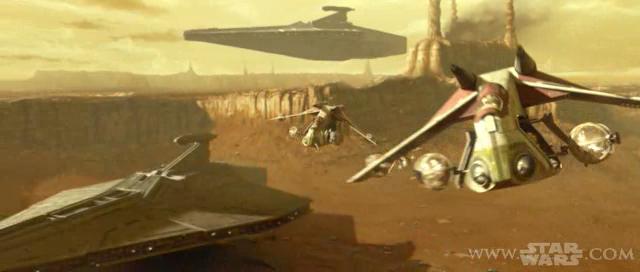
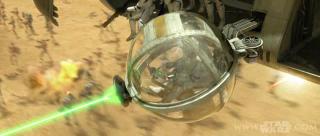
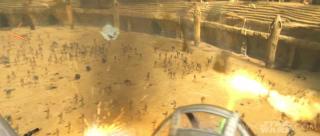
Republic gunships can open up quite a large can o' whoop-ass on the enemy when needed. They bear a striking resemblance to the real-life Hind helicopter gunship, and they demonstrated their effectiveness against enemy infantry in the arena rescue, when they effortlessly annihilated the arena's battle droids before picking up Jedi survivors from the floor. They appeared to be well protected against small-arms fire, sustaining numerous direct hits from battle droid armament with no effect apart from small scorch-marks.
They carry an array of ball turrets, but the most striking example was the pair of externally mounted micro-superlaser ball turrets, seen in the pictures above. These weapons used a personal-scale version of the Death Star superlaser, thus proving the validity of the speculation (shared by myself and many others) that superlaser technology was not unique to the Death Star (in fact, it was obviously common and widespread), and that no scientific breakthroughs were necessary (obviously there were enormous engineering and materials science hurdles, but the SW civilization has obviously possessed giant-scale engineering skills for some time, given the examples of Imperial City and Centrepoint Station). How long will it be before these damned EU writers recognize that the SW galaxy is far too advanced to still suffer through present-day technological cycles of 20 or 40 years, so that anything which is effective must be brand new? In any case, the micro-superlaser sliced cleanly through battle droids and super battle droids without apparent impedance, and it had an explosive area effect upon ground contact, as seen in the screenshots above. In one of the large battle scenes we can also see that the micro-superlaser is quite effective against enemy armour as well, as it slices cleanly through a wheel-droid with lethal results (although it should be pointed out that a wheel-droid is not particularly well-armoured). The SW2ICS quantifies its maximum yield at 300 GJ, but since it is a continuous beam and we don't know the shot duration involved in the generation of this figure, it is difficult to translate this to a power level. However, in the movie we never see it fire for more than one second, so it appears to be a 300 GW beam. Given its ability to effortlessly sweep through enemy armour (never mind battle droids), this figure does not seem unreasonable.
Republic gunships are also loaded with a complement of heavy air-to-ground missiles, which launch through two dorsally mounted firing tubes and which are stored in a large dorsal magazine with an auto-loader. These missiles appear to quite flexible, being used against mammoth targets such as parked starships as well as enemy armour (eg- the wheel-droids). The placement is interesting from a defensive standpoint; the missiles are inside the armoured shell of the gunship, rather than being mounted externally on wing hardpoints. This confers a few advantages:
The only way to get a shot directly at the missiles is to be above and behind the gunship (a lethal approach vector for any aircraft). Considering the rescue tactics we saw of literally flying right through troop concentrations at grass-skimming altitudes and blasting them at point-blank range, this kind of protection can be useful.
They can carry a lot of large missiles. You would need a lot of hardpoint to load that many missiles onto the wings, and if you loaded them into clustered launchers, they would be huge. Their ground-skimming tactic of using their bodies to protect beleaguered ground troops would have been pretty risky if battle droids could literally reach out and touch these giant missile clusters as they flew by.
Assisted launch mechanism. Given the large size of the launch tubes, the presence of power-assisted launch systems seems obvious, and the SW2ICS confirms this in its diagrams. Presumably, this system accelerates the missiles to speed, thus saving time and rocket fuel. It may also perform some other function, such as configuring the missile (assuming the missile is configurable).
The SW2ICS describes different types and yields of missile which can be loaded into the system, which seems reasonable. The missiles which happen to be loaded into the gunship shown in the diagram are described as 100 kiloton shaped-charge blast-effect devices which focus their effects into a thin two-degree cone, which is interesting; does "blast-effect" imply that they produce a shockwave without a significant heating effect, like Slave-1's seismic charges? In any case, they appeared to be carrying much lower-yield general-purpose missiles in the Geonosis battle; a loadout choice which proved useful when hitting wheel-droids which were only a few kilometres from their own troops, but which undoubtedly frustrated them when they tried and failed to damage Trade Federation core ships. The SW2ICS also mentions 8 air-to-air rockets (wing-mounted: four on the underside of each wing), but when ordered to shoot down Count Dooku's speeder, the pilot replied that they were out, which indicates that they had already engaged in air combat (it is an unfortunate side-effect of the confusion of war that we could not see these engagements). One item of note is the fact that they made no effort to use their tail guns or external ball turrets in order to shoot at their pursuers on the way to Dooku's hangar; were they out of energy? The gunship was still flying, but perhaps the guns have a separate energy source, analogous to a limited supply of ammunition. Alternatively, the energy required to fire a gun (with enough power to damage a fighter) may be much greater than the energy required to fly. While the pilot said they were "out of rockets" in the film, he said that they were "out of ordnance" in the novelization, which would be consistent with this speculation.
The novelization describes active shielding twice:
"A hailstorm of laserfire blasted the new arrivals, but the gunships had their shields up, covering the debarkation of their warriors." p.331
"Obi-Wan, Anakin, and Padme crouched in the open side of a gunship as it sped across the expanding battlefield outside the arena, its laser cannons blaring, its shields turning back the responding fire from the droids." p.334-335
This makes sense in light of the Geonosian fighter shot that knocked Amidala out the window; it was a direct hit from behind, but while it rocked the gunship, it did not cause any serious damage, and it "detonated" prematurely, before hitting the ship. Subsequent shots from the same fighters' weapons blasted the gunship to pieces after it dropped off Obi-Wan and Anakin at the hangar platform; a sudden increase in lethality which is not easily explained unless one postulates the presence of ray shields. The "flak bursts" around the gunships help substantiate the presence of ray shields; if a ray shield is a volumetric refraction/scattering phenomenon (as demonstrated by the Tantive IV in ANH) with a highly reflective boundary condition at the hull, near misses could potentially undergo a runaway scattering effect in which they disperse into showers of smaller bolts, which in turn disperse into yet smaller showers, thus giving the appearance of a "flak burst".
Active shielding would help explain their arena tactics. None of the gunships took even the slightest damage despite their large transparent cockpit windows and the fact that they deliberately put themselves in harm's way rather than firing on the arena droids from altitude (they literally swept across the arena floor only a few feet above the ground, blasting away at droids from point blank range). This seems somewhat implausible without shielding, but it makes perfect sense with shielding. Of course, this raises the question of how people could get in or out. There might have been a hole in the shield around the side hatch, or perhaps the shield is a pure ray shield which has no effect on matter. Since Mace Windu and other Jedi knights were blocking shots with their lightsabres while standing in the side hatches, I am inclined to lean toward the former possibility; the shield has a gap in that region, which presumably closes only when the doors close.
The gunships' missiles appeared to be ineffective against the large Trade Federation core ships, but they were effective on all other targets in the battle, including the large cylindrical Commerce Guild ships which were mixed in among the core ships. The fact that they didn't even try their micro-superlasers when their missiles proved ineffective indicates that their missiles are more powerful than the micro-superlaser blasts. As the ground battle began in earnest, we could see squadrons of gunships peeling off and flying behind the front lines, hitting columns of wheel droids heading toward the battle in order to neutralize the droid army's most dangerous armoured units. In fact, no wheel droids ever managed to reach the clone army's positions despite their great speed. This indicates that their advance was effectively halted, either by the gunships alone or by a combination of gunship fire and artillery.

According to the Kaminoan cloners, the clone troopers were bred and trained for combat skills and unquestioning obedience to the chain of command. Their rather large weapons are at the upper bound of the small-arms categorization, unlike the small carbines that would eventually become common among Imperial stormtroopers. This armament indicates that the clone troopers were intended for large-scale assaults, rather than urban pacification and policing duties.
Like the Imperial stormtroopers of the original trilogy, the clone troopers (who were obviously their predecessors) have sealed combat armour. This confers numerous advantages in battle:
In-helmet communications, thus improving co-ordination of troop movements.
Ability to see through dust and smoke with in-helmet enhanced displays, as demonstrated when one of the Trade Federation core ships was shot down by heavy artillery. The resulting mammoth cloud of dust, debris, and smoke had no discernible effect on the clone troopers' combat effectiveness whatsoever. They continued to hold their positions and accurately annihilate incoming battle droids, not one of which was ever seen to breach the clone troopers' positions. If their in-helmet displays were similar to the scope on Zam Wessel's weapon, they probably incorporated similar targeting aids, such as its lock-on graphics.
Resistance to shrapnel, which reduces the area effect of explosive weapons. This was demonstrated most strikingly when a wheel-droid destroyed one of the AT-TE's. Clone troopers clustered around the AT-TE were not killed or apparently even injured by the explosion. This greatly reduces the ease with which explosive weapons can be used to take out large troop concentrations.
Ability to survive chemical and biological warfare. The toxic chemicals which would have undoubtedly been released by the destruction of a Federation core ship had no more effect on the clone army than the smoke, dust, and debris of the explosion.
The clone troopers' armour is slightly different than the Imperial stormtrooper armour which would someday replace it. Key differences include:
Some sort of heavy fabric (perhaps a Kevlar-like material) for the black flexible "body glove" under the armour. Imperial stormtroopers used a rubbery or neoprene-like material instead, presumably for better durability or easier cleaning.
A visible flexible area at the top of the chest plate, just below the front of the helmet. Imperial stormtrooper armour provides better coverage in that important area, where an injury could easily be lethal.
Separate upper-arm, shoulder-pad, and elbow armour segments. Imperial stormtrooper armour dispenses with the elbow segment and uses a single piece that covers the upper arm and wraps around the shoulder, thus increasing protection for the upper arm while decreasing protection for the elbow. It may be that the elbow segments were uncomfortable and the shoulder flexibility deemed unnecessary, hence the changes when Imperial stormtroopers appeared. Another possibility is that it was done for simple reasons of economics; when manufacturing millions or billions of armour suits, the reduction of three components into one would save a great deal of money.
Larger helmets. Imperial stormtrooper helmets were smaller and dispensed with the decorative fin. When they designed the stormtrooper helmet, they apparently decided to squeeze components such as air filtration and sensor suites into the bulge around the helmet base.
Rank colour coding.
The clone troopers' armament was quite powerful; battle droids hit by their small-arms fire were not just disabled, but fragmented. Battle droids, super battle droids, and destroyer droids all seemed equally vulnerable to their weaponry, and it seems likely that their guns were designed for the express purpose of rapidly annihilating battle droids, even those with small onboard shield generators such as those of heavy destroyer droids. According to the SWVD, one clip carries 500 shots, and according to the SW2ICS, one max-power shot can blast a ½-metre crater in any ferrocrete wall. If we assume the properties of ferrocrete are halfway between those of concrete and steel, this indicates energy equivalence to roughly 2kg of TNT, or roughly eight times the charge of a modern MK3A2 concussion grenade, so their destructive capabilities are not surprising. The bolt colour is somewhat interesting; like the AT-TEs, the clone troopers' guns fired blue bolts instead of the red bolts that characterized Imperial walkers and stormtroopers. It has been suggested that this colour indicated that they were ion cannons, but the blue colour of ion cannons is a computer game convention that has no basis in the canon films (the ion cannon in TESB fired red bolts). Moreover, these guns caused heavy physical damage, blasting droids into scrap rather than simply disabling them.
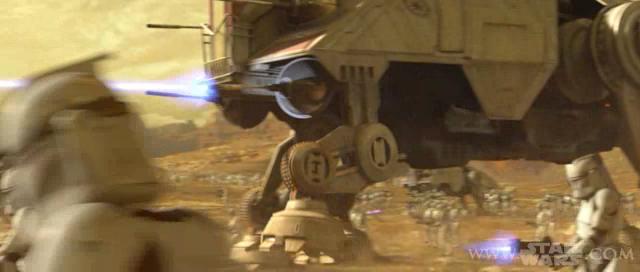
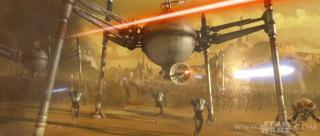

The AT-TE is a much smaller, weaker version of the mighty AT-ATs that would someday strike terror into the hearts of the Empire's enemies. It carries an array of small ball turrets, presumably for infantry support, and a large dorsal gun turret similar to the main gun on a modern tank.
It is obviously immune to small-arms fire, but not to the guided missiles of enemy wheel-droids. In the above screenshots, you can see its main armament destroying a spider-droid (behind and to the left of the foreground droid; the target spider erupts in a bright yellow flash upon impact in the third image). According to the SW2ICS, the main gun is a railgun. However, the visuals suggested an energy bolt instead. I suppose I should note here that some Trekkies are ignoring any attempt at rationalization in their zeal to portray any conceivable "inconsistency" between the SW2ICS and the film as an excuse to dismiss the entire SW2ICS, which is the only officially approved book to contain SI unit specs for SW technology (ironically, this same crowd uses the TNG TM even though its own publishers call it mere "speculation", and they base entire tech arguments on SW "extended universe" novels whose connection to the films is tenuous and whose consistency with the films is laughable at best; obviously, you can't expect rational consistency from this bunch). However, assuming you are not one of these people and you are honestly interested in understanding this material rather than looking for an excuse to bury your head in the sand, there are several possible rationalizations:
The gun can be switched to a different weapon type by swapping out some internal components, while using the same turret and barrel.
The gun is a railgun, but it has different ammunition types, much like a modern tank carries HEAT, sabot, etc. One of these ammunition types bears a visual resemblance to an energy bolt (remember that the Falcon's concussion missiles looked like energy bolts in ROTJ).
The visual trail is a tracer effect.
The visual trail is a result of the railgun projectile's ablation from air friction.
The AT-TE appears designed to support infantry by destroying enemy armour from a distance and using its light guns to pound troop concentrations or knock out light enemy armour (such as dwarf spider droids). It appears that the AT-TE's were depressing their ball turrets to fire at the ground near groups of enemy droids, hence the concussive ground blasts which destroyed groups of battle droids onscreen. According to the SW2ICS, its ball turrets had a yield of roughly 5 GJ per shot, which is roughly equivalent to the energy yield of a 2000 pound bomb (although it should be noted that an energy weapon will have much less efficient force-coupling than a chemical explosive). Another application for their ball turrets would have been to target enemy spider droids.
The AT-TEs appeared to stay with the infantry during the entire engagement. However, the vehicle's maximum speed is 60 km/h, so a better use of the AT-TE's might have been for most of them to accelerate to full speed and punch through the droids' lines, using their armour and mobility to penetrate deeply into the enemy's rear and sow confusion into his lines. It may be that their failure to use the AT-TE's in this manner was due to their inexperience with the platform, or perhaps their adoption of a largely defensive posture (although, as they say, the best defense can be a good offense).
AT-TE deployment is one of its strongest suits. Each AT-TE has a dedicated repulsorlift device which can bring it to the deployment point at high speed and drop it on the ground, whereupon it is combat-effective immediately. No modern armour has the ability to air-deploy so quickly and easily.
The SPHA-T is a continuous-beam heavy artillery platform. Its mobility is extremely low because of its large size, so it is obviously not intended to for close-range combat. It can depress its weapon below the horizontal plane in order to shoot at ground targets, or it can elevate to high angles in order to shoot down heavily armoured aerial targets such as the Trade Federation core ships. This is an extra artillery requirement that does not exist in real life, where there is no such thing as a heavily armoured, huge air vehicle, although the infamous WW2 German 88's were designed to fire at both air and ground targets. However, even WW2 aircraft, while far more durable than modern aircraft in many ways, were not comparable to an armoured naval vessel. The ability to inflict crippling damage to a capital-ship is well beyond the limits of tanks (never mind small-arms fire), so this capability can be very useful for a ground army.
Unfortunately, we never saw what the SPHA-T's were doing before they elevated their guns to engage the core ship. Given the fact that their barrels had been pointed at the droid army before redirecting skyward, it seems self-evident that they were supporting the infantry and armour by firing at enemy positions. They might have been aiming at distant positions in order to eliminate any second wave so that it cannot reinforce the first, or they might have tried to lay down fire in front of the first wave, in order to blunt their advance (although the droids were so close to the clone army's positions that the latter option might have been a friendly-fire risk).
The close proximity of the two armies is initially confusing, since their collective firepower was such that they should have had some difficulty approaching each other to such range without being decimated in the process. However, we should not assume that the droid army approached the clone army entirely overland, or that the clone army landed almost on top of a droid army which was in plain sight. In fact, the droid army was probably not visible when the clone army landed and first began deploying troops (remember that there was no sign of it when Obi-Wan and later, Anakin and Amidala landed on the planet). Given the fact that the droid army was streaming into the lowest level of the arena (which was basically a huge pit in the ground), the fact that the factory was entirely underground, and the fact that Geonosian society itself is basically underground, it seems obvious that the droid army was probably being stored underground, where only a pre-emptive strike with powerful weapons of mass destruction would have been effective. Since Yoda was in command of the operation(!), the likelihood of such an action seems vanishingly small, particularly given the fact that they were in close proximity to a Geonosian catacomb "city" (the rock spires are the Geonosian equivalent of residential neighbourhoods) and its outdoor arena.
This would imply that the droid army deployed from underground staging areas, hence the short range of the initial engagement. After the first wave of infantry and armour was annihilated, the remainder of the droid army, already reeling from long-range artillery strikes and airstrikes and lacking any artillery of their own, was forced into full retreat.
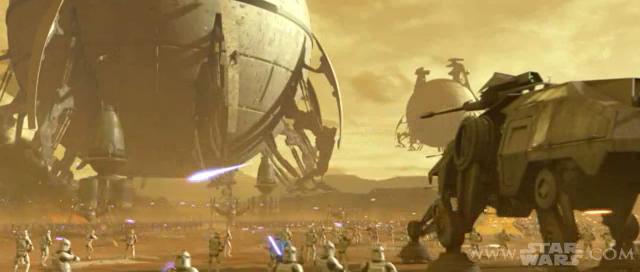
The Trade Federation core ship seems to be a separable command module for their battleships (it connects to the ring-shaped portion of the ship). No armament was in evidence, although it was interesting that the ships (some 700 metres in diameter) were capable of ground landings and takeoffs. They even have huge landing gear!
Unfortunately for the core ships, they did not appear to be capable of surviving heavy artillery. Sustained fire from a Republic SPHA-T's can literally carve up a core ship like a Thanksgiving turkey, and we saw one ship suffer such severe internal damage that its propulsion system completely failed and it came crashing back down to the ground, with an enormous explosion and consequent cloud of smoke and debris.
One interesting question relates to shields: why were the core ships not shielded? We discovered in TPM that a Trade Federation battleship's shielding is easily enough to ward off sustained proton torpedo and blaster attacks from an entire squadron of fighters, so why was it seemingly useless against the SPHA-T's? Could an SPHA-T's main gun be that much more powerful than proton torpedoes? In fact, it appears that the core ships had no shielding at all (even though we know they are capable of generating shields), which may be explained by the presence of a semi-permeable theatre shield. Such shields do not necessarily block physical objects (as we saw in TPM), but they block high-velocity objects and energy blasts, thus affording some measure of protection against orbital bombardment. However, they seem to produce a volume interaction which prevents shield use inside the perimeter, as noted from TPM where none of the destroyer droids used their shields inside the Gungan shield perimeter.
However, there is credible evidence that the Republic gunships were using active shielding, so this explanation might not work. Another possibility is that the core ships needed to retract their sizable landing gear before they could activate their shields, because the shields conform to their spherical shape. A third possibility is that the core ship has no tactical systems (we saw no fire coming from them, so this is more of an observation than a theory), and that a complete Trade Federation battleship's shields are actually projected from the "ring" portion of the ship (the ship might be designed so that each part cannot function effectively on its own; the core ship might contain the command module and main reactor while tactical systems and hyperdrive reside in the ring section).
The Acclamator's role is to engage starships en route to planetary targets if necessary, and then debark ground troops upon planet-fall. Unfortunately, since we did not see the Acclamators approach Geonosis, we had no chance to see their effectiveness against enemy starships. And since weapons of mass destruction are considered a highly provocative escalation in warfare, it is not surprising that their guns were not used during the battle (particularly since Yoda was in command).
However, the SW2ICS quantifies their official capabilities for us: each Acclamator carries 12 200-gigaton quad-turbolaser turrets, and 24 6-megaton light guns, in addition to being armed with four huge forward-firing missile launch tubes. There are lots of other specifications in SW2ICS, but I don't see the point in regurgitating all of those specifications here. Instead, I would encourage you to go buy a copy of the SW2ICS for yourself.
One item of note is that Acclamators can theoretically deploy gunships before they land, since they need only open the doors and let the gunships fly out with their own repulsorlift drives. When Yoda's gunships fly into the arena, you can see Acclamators cruising in the sky above, and the gunships probably deployed from those Acclamators. The Geonosians' total surprise is consistent with this theory; no one seemed to have any idea that Yoda was coming until he was already dropping down in the arena, which would make sense if the Acclamators burst out of hyperspace in low altitude, flew straight into the lower atmosphere, and disgorged gunships in the air over the arena immediately.
The Acclamators and their associated forces are designed for extremely fast troop deployments. Even before they touch down, they can use their gunships and repulsorlift airhooks to begin deploying their troops. Within one minute of appearing in the skies above the Geonosian arena, they already had thousands of troops on the ground, as well as armoured vehicles in support! These forces were obviously designed for air mobility; they are, in effect, an ultra-heavily armed paratrooper force, since they can deploy everything but their heavy artillery without having to land their spacecraft.
In addition to the standard Tradefed battle droids and destroyer droids from TPM, we saw 5 new droid types in AOTC:
Tradefed super battle droids. These droids were bipedal with much heavier upper bodies than regular battle droids. Instead of carrying a conventional blaster, super battle droids have a double-barrelled repeating blaster built right onto the end of the right arm. Without the DVD I cannot time the shots, but I would estimate a firing rate somewhere between 300 and 600 shots per minute. It would appear that these droids may have been designed to serve in the squad-level support role, although in practice, they did not perform in that role and their combat effectiveness was not significantly different from that of standard-issue battle droids.
Inter-Galactic Banking Clan Hailfire droids (wheel-droids).
These droids are analogous to modern MLRS artillery, albeit with
guided missiles instead of dumb-fire rockets (thus making them much
more dangerous). Each droid carries 30 missiles, each of which is
powerful enough to destroy an AT-TE. These droids also appear to
serve as mobile SAMs, so they constituted the majority of the droid
army's air defense (small wonder the gunships went after them). In
addition to their rockets, they also appear to carry AA guns, even
though they are not labelled as such on the Visual Dictionary's
diagram. Consider the following screenshot: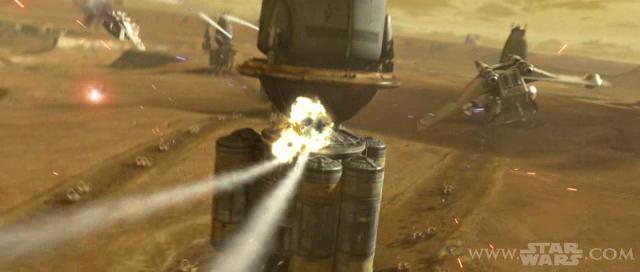
You
can clearly see AA fire coming from both columns of wheel-droids. It
would appear that Hailfire droids are still combat-effective even
after exhausting their rocket payload. Given this undocumented but
clearly visible auxiliary armament, It is clear why the gunships
ranged behind enemy lines to attack the wheel-droid columns: the
Hailfire droids carried a disproportionate amount of the droid
army's firepower, and they appeared to constitute the majority of
its air defense.
Commerce Guild Homing spider droids (large spiders). These droids are roughly analogous to heavy tanks. They carry a heavy blaster and their unusual appearance belies the tactical advantages of its low target profile. Its long, spindly legs make it appear like a bigger target than it really is. Since the legs cannot be realistically targeted, an enemy gunner must aim for the spider's small spherical "body". However, we saw no evidence of the effectiveness of its main gun. The only confirmed AT-TE kills were from Hailfire missiles, and if its armament was inadequate to pierce AT-TE frontal armour, it is at a significant tactical disadvantage (since spider droids were destroyed easily by AT-TE fire onscreen).
Commerce Guild Dwarf spider droids (small spiders). These droids are roughly analogous to light tanks or perhaps recon vehicles, although the recon role may have been largely usurped by repulsorlift droids in the Star Wars galaxy. As with the larger spider-droids, their effectiveness in battle was questionable, since we never saw them breach the clone army's lines despite a determined advance. It is entirely possible that dwarf spider droids cannot survive clonetrooper small-arms fire, thus making them little more than cannon fodder. They certainly would not survive fire from an AT-TE's ball turrets.
Corporate Alliance tank droids. While it is difficult to be sure without thoroughly analyzing the film with the luxury of DVD frame-advance, I could not recall seeing any of these large rolling droids in action. Based on the picture in SWVD, models were obviously made for the film, but they might not have been shown prominently in any of the battle scenes. Perhaps the nearest supply of tank droids was too remote to participate in this battle before it was over, or perhaps they were sighted and destroyed by artillery or airstrikes at long distance, well before they were able to come within range of the front lines.
There are also Geonosian gun emplacements mentioned in the script, but they were not shown onscreen.
The droid army appears to have some of the elements of a proper ground army. It has infantry, light tanks, medium battle tanks, heavy tanks (although we didn't see these), and rocket artillery, as well as AA defense. However, it has no heavy artillery, and its air support was either nonexistent or wiped out in the opening moments of the battle. We know that two types of air support should have been present: droid fighters (as seen in TPM) and Geonosian fighters. However, it is possible that the Acclamators targeted exposed hangars or air fields on the way down, or that gunships attacked these hangars or air fields after touchdown. Another possibility is that gunships engaged droid and Geonosian fighters in aerial combat, and that we were simply unfortunate not to see this during our brief glimpses of the battle.
One interesting question relates to the lack of droidekas in the battle. We know that droidekas were present, since we saw them in the arena. However, we saw none during the battle. The sheer confusion and violence of the battle made it difficult to be sure that none were present, but it is nevertheless curious that we didn't see any. In TPM, they deployed from within the droid infantry, rushing forward into the enemy formations and deploying in their midst in order to split their concentration and fire. The combination of high speed and small target profile should have made this tactic effective here as well, but perhaps there were only a small number available; not enough to be visually obvious in the confusion of a large battlefield. Perhaps the droidekas were mostly loaded onto Trade federation starships at the time.
Count Dooku's starship demonstrates the great acceleration of repulsorlift drives when he lifts off from Geonosis. Watch the movie and notice the sequence:
Amidala lands at the hangar.
Dooku lifts off.
Amidala sees him lifting off and fires at him, as do the clone troopers.
Dooku is already out of small-arms range, and he continues to accelerate until he leaves the atmosphere. He passes several Trade Federation battleships in orbit well outside the planet's asteroid belts, and unfurls his interesting sail device.
Yoda grimaces and picks up his cane.
Amidala rushes to Anakin's side.
No, that's not a misprint. Once Count Dooku clears the hangar and his pilot droid "kicks it into gear", he accelerates away from the hangar so quickly that we can see he is well past the planet's asteroid rings before Yoda bothers to pick up his cane, and well before Amidala is able to run (not walk) from the hangar landing spit into the hangar where Anakin lays injured. How long could this possibly have taken? We are talking about not minutes, but seconds.
The SW2ICS figures appear to be much too conservative, although any discrepancy might be explained through Count Dooku's habitual secrecy. His ship is said to have a maximum acceleration of 30G with its thrusters and 1000G with its sail deployed, and be limited to an airspeed of only 1600 km/h. However, the asteroid ring diameter is roughly twice that of the planet, which means that Dooku must have reached an altitude of at least 10,000 km before unfurling his sail.
These figures are much too conservative to explain the ship's great acceleration in the movie, even if we assume that the 1600 km/h maximum airspeed increases rapidly with altitude (since it's obviously an aerodynamic limitation) and ignore it. At a constant 30G acceleration, it would take more than four minutes to reach 10,000km. This is completely unreasonable. No one can seriously believe that Amidala and the clone troopers stood on the hangar platform for four minutes, or that Yoda stood frozen in place for four minutes before picking up his cane!
How long could Amidala have been expected to stand on the platform staring at Dooku's wake before running inside to check on Anakin and Obi-Wan? She was obviously not in a leisurely mood; she ran into the hangar looking for Anakin! And how long could Yoda have been expected to stand there, frozen in place, before picking up his cane? Frankly, anything more than 10 or 20 seconds is grossly unrealistic. This means that Dooku's ship had to cover 10,000 km in 10 to 20 seconds, which requires constant acceleration between 5,000 and 20,000 G.
Another open issue with the starship is its billowing sail device. This appears to be related to its hyperdrive, and it is not a simple impulse propulsion system as per the classic sci-fi "solar sail" concept. Note that the ship accelerates from the ground to space without this device, which does not unfurl until the ship reaches orbit. Also note that it retracts the device in order to enter Coruscant's atmosphere. Therefore, we can rule out the classic "solar sail" concept which only produces linear force, and which obviously has nothing to do with superluminal propulsion. Count Dooku's "solar sail" is nothing of the sort, and it is obviously some kind of exotic hyperdrive system. The SW2ICS indicates that it is a leftover from some ancient spacefaring civilization and that Dooku uses it as a fashion statement as much as anything else, which seems far more reasonable than the solar sailer idea.
Many fans have questioned why R2D2 has rockets in AOTC but not in the original trilogy. The official answer is that the rockets were a delicately balanced system and they went out of warranty by the time of ANH, but that is a highly unsatisfactory solution. R2 units obviously have great longevity, as evidenced by the fact that R2D2 was fully functional more than 30 years after we first saw him. Moreover, spare parts are still plentiful, as demonstrated when the Rebels easily put him back together after the top of his head was literally blown off in the Battle of Yavin in ANH (the rest of his body took serious damage as well). Service manuals and expertise are obviously available (see previous example). And finally, the fact that something is out of warranty does not preclude its use! The world is full of technological devices which are being used well beyond their warranties.
In order to answer the question of R2's rockets, we must look at the question of what an R2 unit is. R2D2 is an astromech droid. His job is to perform maintenance on starships. That is why astromech droids are found in X-wing starfighters, Delta-7 starfighters, and the Naboo royal starship. But how does he do it? Can R2D2 realistically reach every system on a starfighter with that puny little extendable arm of his, while strapped into his socket? Of course not. If an X-wing fighter were ever damaged and left adrift in space, its pilot is doomed unless somebody can go outside the ship and perform maintenance. Since X-wing pilots don't wear full spacesuits (unlike TIE pilots), they can't do it themselves. So who's going to do it? You guessed it; the astromech droid needs to be able to get out of that socket and fix the ship. And if he loses his grip or he can't trundle along the uneven hull of an X-wing with his mag-clamp wheels (how's he going to get to the underside of the ship?), he's going to need rockets to maneuver.
So why didn't he use them in the original trilogy? The answer would come from the fact that an astromech's rocket thrusters would obviously be designed for zero-g conditions. Once we know this, one "quick and dirty" solution is that Geonosis is a low-gravity world, so he could use his rockets there but not in the original trilogy. However, while entirely possible, it's a bit of a stretch. There are limits to how much lower its gravity could be (the planet had to retain an atmosphere, after all), so this theory relies on the notion that the rockets would be capable of fighting, say, 85% of Earth gravity but not 100%. That's a pretty tight margin, and either way, it would be huge overkill for zero-g maneuvers. While Geonosis' low gravity may have made the job easier than it would have been on a planet with higher gravity, it's too convenient to simply say that it's impossible at normal gravity but OK at slightly less than normal gravity.
Is it necessary to resort to this explanation? Or are there other reasons that we never saw R2 using his rockets? In order to use his rockets in a gravity well, R2 would have to run them at maximum power just to combat gravity, and this means that he would quickly use up all his fuel and put undue wear and tear on the system. Obviously, he wouldn't do this unless it's an emergency. Let's look at the original trilogy and ask ourselves whether there is really any inconsistency here:
ANH: There would have been no point using his rockets on Tatooine; he would travel a few hundred yards at most, use up all his fuel, strain his rockets and possibly damage them in the process, and for what? There was no point in the Death Star either; he was in corridors all the time. There was no point in the Yavin hangar; they have hoists, so why waste precious maneuvering fuel that's supposed to be used for his primary job as an astromech droid in zero-g?
TESB: The rockets might have come in handy when he was trying to get off Luke's X-wing in the Dagobah swamp, but for all we know, he was about to use them before he fell off into the water. In fact, he might have been using them at low power underwater, hence his ability to maintain depth and maneuver even though his wheels would have been utterly useless. And how did he get back up into the X-wing before Luke lifted off from Dagobah? There was no hoist, and he's pretty heavy. Did Luke or Yoda levitate him? Or did he fly up? The fact that we didn't see him using his rockets in TESB doesn't necessarily mean he didn't use them.
ROTJ: The rockets might have come in handy for getting out of the desert when he rolled out of Jabba's barge to avoid the explosion, but he was stuck in the sand, so he would have had to push sand out of the way in order to deploy his rockets. Moreover, there wouldn't have been much point; Luke and the others had a fully functional skiff, they were coming to get him, and there was no emergency, so why risk rocket use in a gravity well? There was also no point using them on Endor, where he would have only used up all his fuel and strained the system for a few hundred yards of distance. Worse yet, he would be separated from the group, and the noise and sight of a flying droid would make it more difficult to keep their presence a secret. There would have been no point using the rockets when stuck in the Ewok net, since the immediate problem was getting out of the net, and they were captured and tied up immediately afterwards.
If we interpret the rockets as a zero-g maneuvering device which can be used in a gravity well only for short durations and at risk to their integrity, this handily explains why we didn't see them used in the original trilogy, without having to resort to the silly "warranty" explanation. Geonosis was one of the rare cases where it was worth it to use those rockets. One look into that factory and R2 would have known that his owner Amidala was in very serious trouble, and since the factory was designed for flying species, the only way he could help was to use those rockets. We must recognize that this was an extraordinary situation, calling for extraordinary measures on his part; If he did not think it a truly desperate scenario, he would not have shoved C3PO off into the void, quite literally risking C3PO's life in order to get him out of the way so he could get airborne now.
Note: it has been pointed out that the rockets are not mounted on gimbals of any sort, which limits their flexibility and thus R2's maneuverability. Sure enough, R2 has to angle his arms backwards in order to angle the thrust from his rockets, and this leads to questions about precisely how he would accomplish zero-g maneuvers. Does he use his arms, relying on very low-powered bursts in order to keep from overshooting his targets? It would be decidedly unwieldy, although it would work. Or can the rockets fire both up and down, thus allowing him to retro-fire one or both rockets in order to spin or stop? Their structure doesn't appear to allow for such maneuvers, so it seems more reasonable to imagine that in order to improve maneuverability, he can angle the rockets away from his body, by pulling in the upper portion of the support struts.
In the original script (and, I suspect, the novelization as well), a squad of Jedi were sent to find the control ship and shut it down, thus duplicating the tactics of TPM (and assuming that after ten years, the enemy had not bothered to develop a countermeasure for this glaring weakness; there's that Jedi arrogance and stupidity again). The squad successfully shut down the control signal, and all the droids in the arena stopped. A cheer went up from the Jedi, but the droids shattered their euphoria when they suddenly reactivated themselves and resumed their assault. In the final version of the movie, this scene was cut, but we may yet see it on the DVD version of the movie or in a "deleted scenes" special feature. Personally, I'll go against the crowd and say that I'm glad it was cut; it insults the viewer's intelligence to show that the Trade Federation developed a countermeasure, when any intelligent viewer would be stunned if they had not developed such a countermeasure (and I see no reason why the film should cater to unintelligent viewers).
In any case, regardless of whether the countermeasure is implicit or explicit, it obviously exists, so the next question becomes: what is it? I suspect that a big clue can be found in the C3PO incident. C3PO's head was attached to a battle droid body, and a battle droid body was attached to C3PO's head. Many fans found this scene to be objectionable slapstick humour, but as a practicing gearhead, I find it (as Spock would say) fascinating. It indicates that droids have twin processing centres!
Consider: the battle droid body was able to seize control of C3PO's head. It was able to coordinate its movements with other battle droids and take shots at Jedi knights, which means that it had control of his eyes and it could see what he saw. It was also able to shout war cries such as "Die, Jedi dogs!", which means that it had control of his voice box. Conversely, the battle droid head was able to use C3PO's body. It engaged in combat as well as it could (considering the inferior performance characteristics of C3PO's body), and it forced C3PO's body to grab a blaster and shoot at Jedi knights.
But why would a battle droid have two independent processing centres, each of which is obviously capable of doing the job on its own? The answer may lie in the control-ship countermeasure. Let us postulate the following:
The head processor is the same design used 10 years earlier at Naboo, and it shuts down when the control signal is lost. This may be a technical limitation or it may have been a deliberate design decision (giving the Neimoidians a "kill switch" in order to shut down the entire droid army if it ever turns on them).
The body processor is a new design which does not require the control signal. If a special shutdown signal is received from the control ship, it shuts down along with the head processor. But if the control signal merely stops, it assumes that the control ship was destroyed, and it seizes control.
The resulting theory neatly explains everything described or seen in the arena battle with respect to control signals and C3PO:
The battle droid body gets C3PO's head. Its in-body processor does not detect the presence of a battle droid brain, so it assumes that the control ship has been destroyed. It goes independent, using the inputs from C3PO's audio/video sensors to guide its decision-making and movements. At one point it even sends words to C3PO's voice box, but after letting one epithet through, C3PO is able to quickly override that.
C3PO's body gets a battle droid head, which takes control of C3PO's body because C3PO's body was never really meant to control its own actions without higher-brain functions present (apart from rudimentary autonomic functions such as remaining upright). It is able to fight despite the poor performance of C3PO's body (at one point it actually complains that it must need maintenance), but it is disabled before the control signal is cut off, so we never get to see if it would have shut down as expected when the control signal stops.
The remaining battle droids shut down briefly when the control signal stops, and then they start themselves up again. This momentary delay would be explained by the switch-over from one processor to the other.
Unless somebody can come up with a better theory, this one seems good for now. If the droids had been designed so that they did not require a control signal at all, there would have been no shutdown (even a temporary one) when the control signal was lost. If the droids had only one processing centre, there would have been no way for the battle droid to control itself while its head could separately control C3PO's body. None of the actions taken by either of the two hybrid droids were consistent with C3PO's intent, so both hybrids were obviously under the control of whichever battle droid component happened to be present.
In TESB, C3PO was blown to pieces by an Imperial stormtrooper. His head went blank, and it did not light up again until Chewbacca reattached it to his body, which indicates that it needs to be connected to his body in order to function. But in AOTC, C3PO's head was lopped off (twice!) and it continued to function anyway. There are two possible explanations for this apparent contradiction:
C3PO's head received an electrical jolt when it was blasted off his body. It overloaded his circuits, and they did not recover again until he was hooked up to his body. Somehow, the connection reset his brain, and restarted him.
C3PO's head has an emergency battery but it doesn't run for very long (say, an hour). When his head was blown off in Bespin, its batteries ran dead long before Chewbacca found him. However, when his head was repeatedly knocked off in AOTC, it was always re-attached within one minute, so we never saw his head lose power.
Personally, I find the second explanation preferable. The presence of an independent power supply in his head is rather intriguing; since a protocol droid is used for communication rather than mechanical work, is it possible that protocol droid bodies are considered an unnecessary luxury, and that some people will grab a protocol droid's head and lug it along with them (presumably with a portable long-term power supply) just in case they need to communicate with an alien species?
Rob Wilson, for general discussion on technology and military tactics, numerous suggestions, etc.
Curtis Saxton, for writing the SW2ICS and for general tech discussion.
Andrew Tse, for general tech discussion and screenshots.
Mark Sheppard, for pointing out that the Jedi confinement forcefield may have been an early UEC precursor.
Aaron D, for pointing out that the possibility of smart-firing on Zam Wessel's sniper rifle.
Ryan Handy, for pointing out the novel's statements on the Delta-7's hyperdrive.
David Erlenbbusch, for mentioning Obi-Wan's short and long range transmitters on his Delta-7.
Steven Heise, for pointing out some of the parallels between the German 88's and the SPHA-T's.
Mark Shantz, for reminding me that the Gungans could use their hand-held shields inside the dome shield perimeter in TPM.
Matthew King, for pointing out the importance of Obi-Wan detecting Anakin's location on Tatooine.
Nathan Thomas, for pointing out that R2D2 did not land upside down when he fell out of Jabba's barge.
Dado Hrustanpasic, for pointing out that Amidala's window shield could not have been a particle shield, and for providing the relevant novel quote.
Mike Horne, for pointing out R2's maneuverability limitations.
Adam Gehrls, for providing me with novel quotes and useful visual source data.
Brandon Davis, for pointing out the wheel-droid AA fire.
Wayne Poe, for mentioning the dual processing centres of the battle droids.
Michel Martin del Campo, for first mentioning the possibility that Fett's "lone wolf" personality had to be dialed down for the clones.